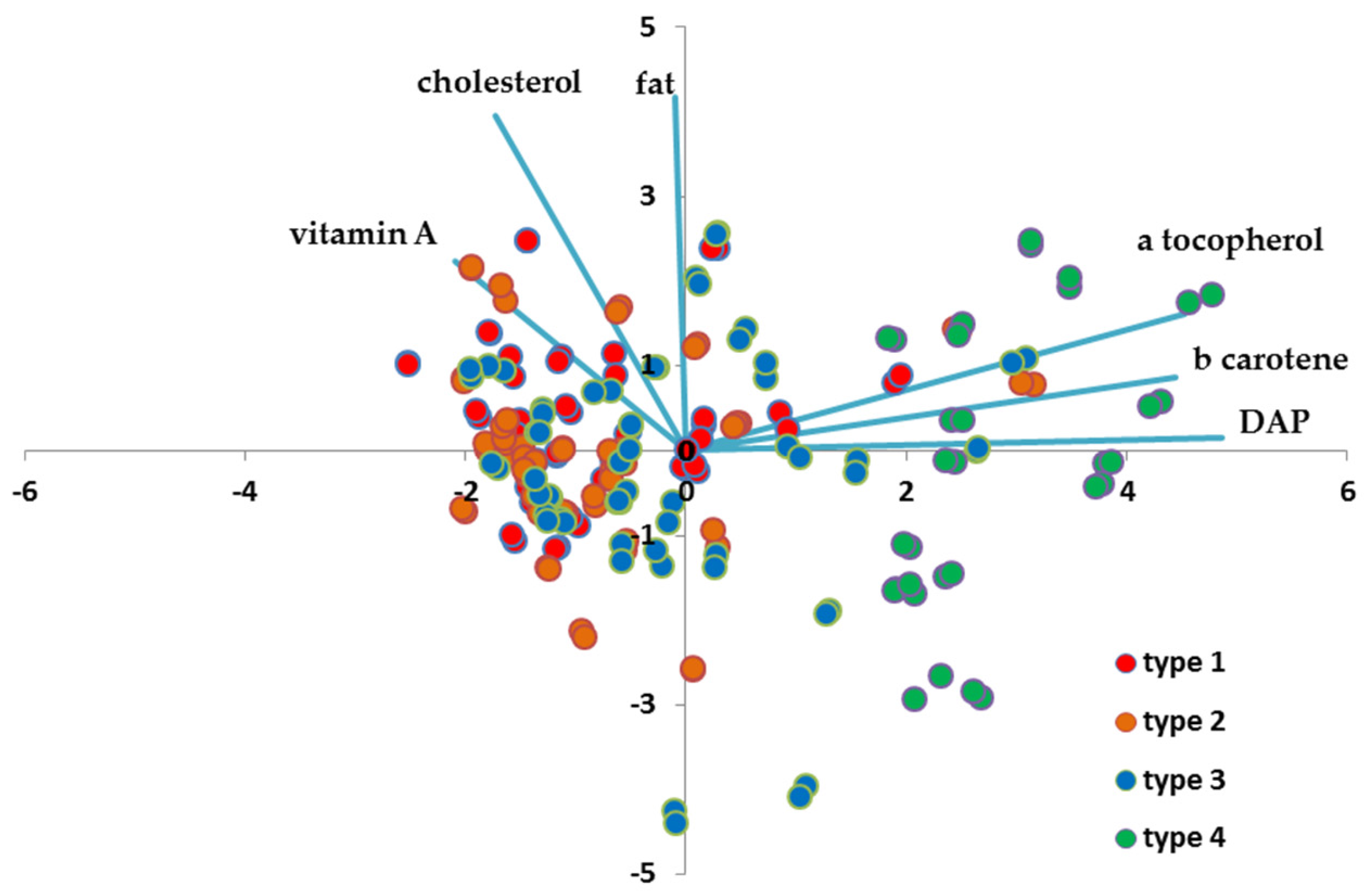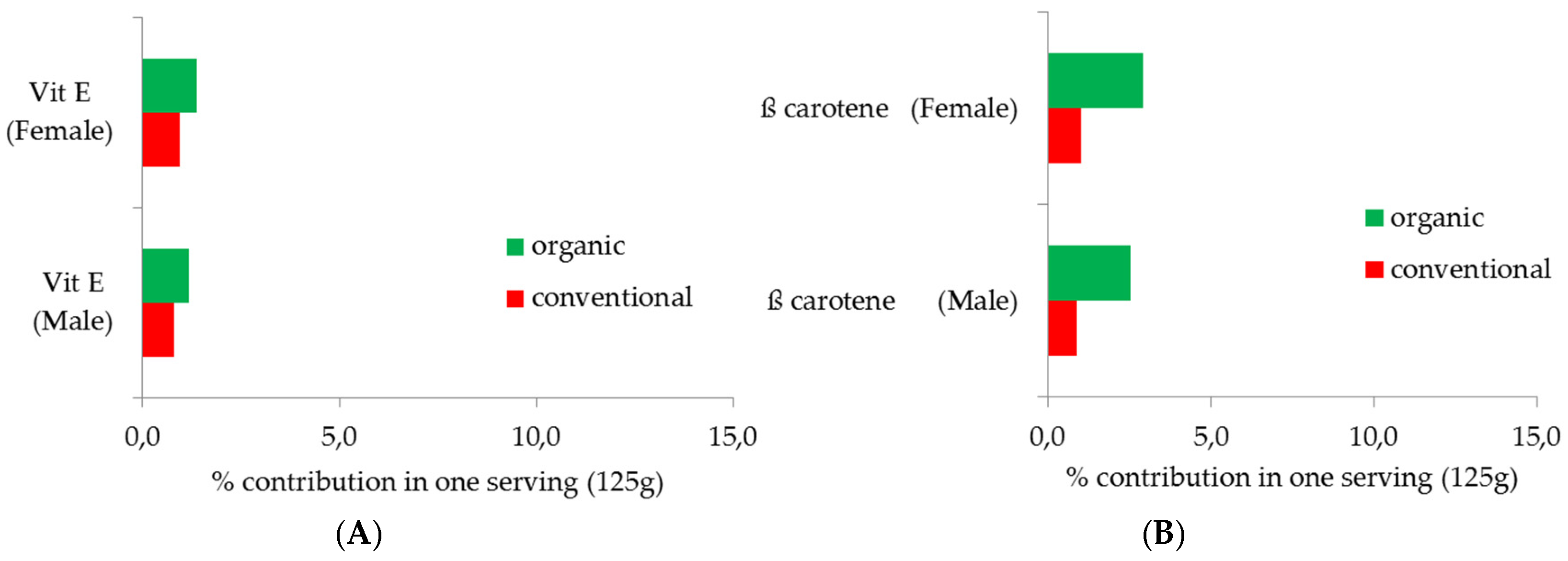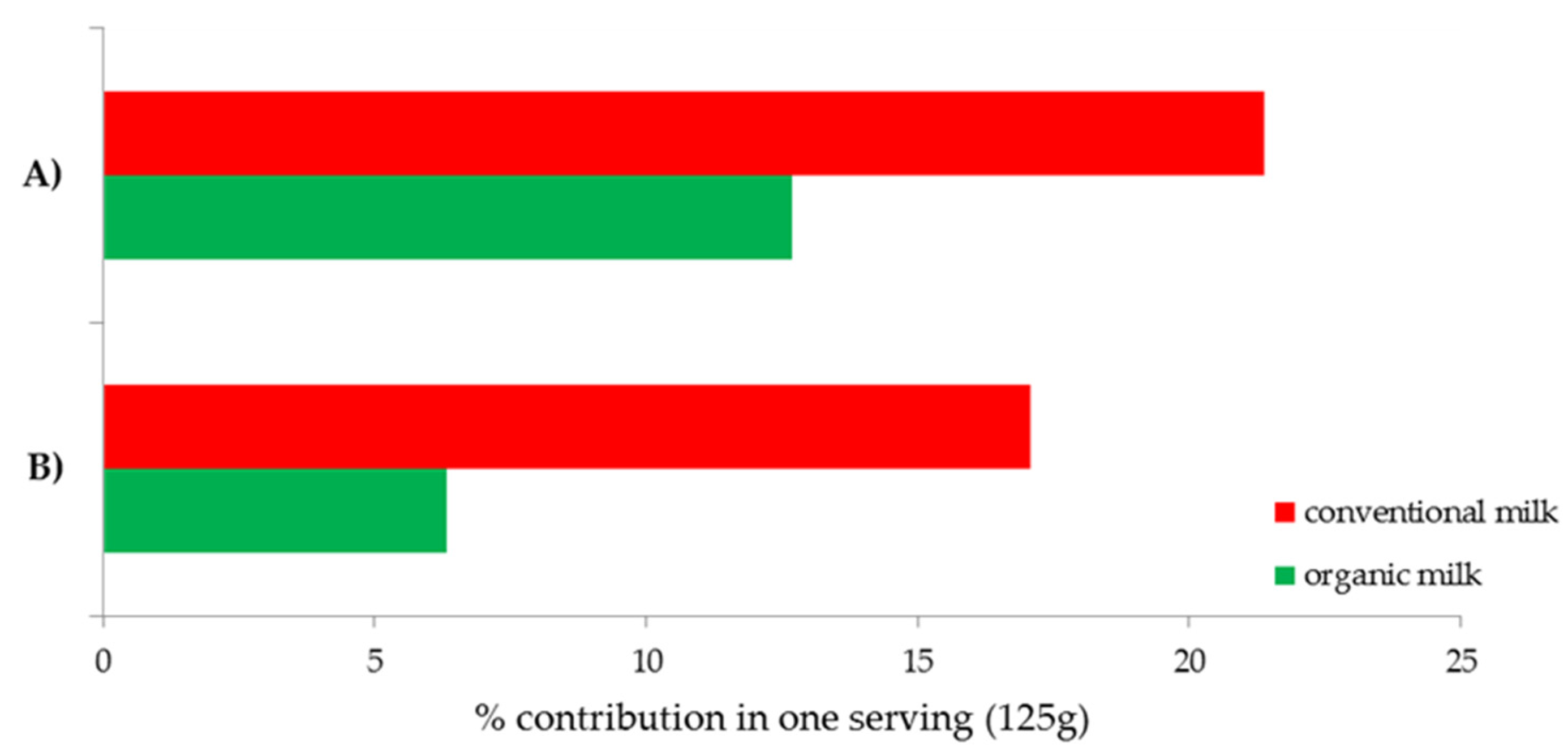Organic vs. Conventional Milk: Some Considerations on Fat-Soluble Vitamins and Iodine Content
Abstract
1. Introduction
2. Organic vs. Conventional Milk: Focus on Fat Fraction and Mineral Content
3. Nutritional Evaluation of Organic Milk in the Diet: Some Considerations on Fat-Soluble Vitamins and Iodine
4. Conclusions
Acknowledgments
Author Contributions
Conflicts of Interest
References
- Willer, H.; Yussefi, M.; Sorensen, N. The World of Organic Agriculture: Statistics and Emerging Trends; IFOAM: Bonn, Germany; FiBL: Frick, Switzerland, 2009. [Google Scholar]
- Costa, S.; Zepeda, L.; Sirieix, L. Exploring the social value of organic food: A qualitative study in france. Int. J. Consum. Stud. 2014, 38, 228–237. [Google Scholar] [CrossRef]
- Organic Milk Market Report 2017. Available online: http://www.omsco.co.uk/marketreport (accessed on 24 July 2017).
- Hughner, R.S.; McDonagh, P.; Prothero, A.; Shultz, C.J.; Stanton, J. Who are organic food consumers? A compilation and review of why people purchase organic food. J. Consum. Behav. 2007, 6, 94–110. [Google Scholar] [CrossRef]
- Rosati, A.; Aumaitre, A. Organic dairy farming in europe. Livest. Prod. Sci. 2004, 90, 41–51. [Google Scholar] [CrossRef]
- Bani, P.; Sandrucci, A. Yield and quality of milk produced according to the organic standards. Sci. Tec. Latt.-Casearia 2003, 54, 267–286. [Google Scholar]
- Mueller, C.; de Baan, L.; Koellner, T. Comparing direct land use impacts on biodiversity of conventional and organic milk—Based on a swedish case study. Int. J. Life Cycle Assess. 2014, 19, 52–68. [Google Scholar] [CrossRef]
- Sundberg, T.; Berglund, B.; Rydhmer, L.; Strandberg, E. Fertility, somatic cell count and milk production in swedish organic and conventional dairy herds. Livest. Sci. 2009, 126, 176–182. [Google Scholar] [CrossRef]
- Müller-Lindenlauf, M.; Deittert, C.; Köpke, U. Assessment of environmental effects, animal welfare and milk quality among organic dairy farms. Livest. Sci. 2010, 128, 140–148. [Google Scholar] [CrossRef]
- Stiglbauer, K.E.; Cicconi-Hogan, K.M.; Richert, R.; Schukken, Y.H.; Ruegg, P.L.; Gamroth, M. Assessment of herd management on organic and conventional dairy farms in the united states. J. Dairy Sci. 2013, 96, 1290–1300. [Google Scholar] [CrossRef] [PubMed]
- Schwendel, B.H.; Wester, T.J.; Morel, P.C.; Tavendale, M.H.; Deadman, C.; Shadbolt, N.M.; Otter, D.E. Invited review: Organic and conventionally produced milk-an evaluation of factors influencing milk composition. J. Dairy Sci. 2015, 98, 721–746. [Google Scholar] [CrossRef] [PubMed]
- Capuano, E.; Gravink, R.; Boerrigter-Eenling, R.; van Ruth, S.M. Fatty acid and triglycerides profiling of retail organic, conventional and pasture milk: Implications for health and authenticity. Int. Dairy J. 2015, 42, 58–63. [Google Scholar] [CrossRef]
- Butler, G.; Nielsen, J.H.; Slots, T.; Seal, C.; Eyre, M.D.; Sanderson, R.; Leifert, C. Fatty acid and fat-soluble antioxidant concentrations in milk from high- and low-input conventional and organic systems: Seasonal variation. J. Sci. Food Agric. 2008, 88, 1431–1441. [Google Scholar] [CrossRef]
- Benbrook, C.M.; Butler, G.; Latif, M.A.; Leifert, C.; Davis, D.R. Organic production enhances milk nutritional quality by shifting fatty acid composition: A united states-wide, 18-month study. PLoS ONE 2013, 8, e82429. [Google Scholar] [CrossRef] [PubMed]
- Popovic-Vranjes, A.; Savic, M.; Pejanovic, R.; Jovanovic, S.; Krajinovic, G. The effect of organic milk production on certain milk quality parameters. Acta Vet. 2011, 61, 415–421. [Google Scholar] [CrossRef]
- Kelley, N.S.; Hubbard, N.E.; Erickson, K.L. Conjugated linoleic acid isomers and cancer. J. Nutr. 2007, 137, 2599–2607. [Google Scholar] [PubMed]
- Churruca, I.; Fernández-Quintela, A.; Portillo, M.P. Conjugated linoleic acid isomers: Differences in metabolism and biological effects. BioFactors 2009, 35, 105–111. [Google Scholar] [CrossRef] [PubMed]
- Butler, G.; Nielsen, J.H.; Larsen, M.K.; Rehberger, B.; Stergiadis, S.; Canever, A.; Leifert, C. The effects of dairy management and processing on quality characteristics of milk and dairy products. NJAS Wagening. J. Life Sci. 2011, 58, 97–102. [Google Scholar] [CrossRef]
- Kelsey, J.; Corl, B.A.; Collier, R.J.; Bauman, D.E. The effect of breed, parity, and stage of lactation on conjugated linoleic acid (CLA) in milk fat from dairy cows. J. Dairy Sci. 2003, 86, 2588–2597. [Google Scholar] [CrossRef]
- Elgersma, A.; Tamminga, S.; Ellen, G. Modifying milk composition through forage. Anim. Feed Sci. Technol. 2006, 131, 207–225. [Google Scholar] [CrossRef]
- Collomb, M.; Schmid, A.; Sieber, R.; Wechsler, D.; Ryhänen, E.-L. Conjugated linoleic acids in milk fat: Variation and physiological effects. Int. Dairy J. 2006, 16, 1347–1361. [Google Scholar] [CrossRef]
- Butler, G.; Collomb, M.; Rehberger, B.; Sanderson, R.; Eyre, M.; Leifert, C. Conjugated linoleic acid isomer concentrations in milk from high- and low-input management dairy systems. J. Sci. Food Agric. 2009, 89, 697–705. [Google Scholar] [CrossRef]
- Bergamo, P.; Fedele, E.; Iannibelli, L.; Marzillo, G. Fat-soluble vitamin contents and fatty acid composition in organic and conventional italian dairy products. Food Chem. 2003, 82, 625–631. [Google Scholar] [CrossRef]
- Palupi, E.; Jayanegara, A.; Ploeger, A.; Kahl, J. Comparison of nutritional quality between conventional and organic dairy products: A meta-analysis. J. Sci. Food Agric. 2012, 92, 2774–2781. [Google Scholar] [CrossRef] [PubMed]
- Srednicka-Tober, D.; Baranski, M.; Seal, C.J.; Sanderson, R.; Benbrook, C.; Steinshamn, H.; Gromadzka-Ostrowska, J.; Rembialkowska, E.; Skwarlo-Sonta, K.; Eyre, M.; et al. Higher pufa and n-3 pufa, conjugated linoleic acid, alpha-tocopherol and iron, but lower iodine and selenium concentrations in organic milk: A systematic literature review and meta- and redundancy analyses. Br. J. Nutr. 2016, 115, 1043–1060. [Google Scholar] [CrossRef] [PubMed]
- Simopoulos, A.P. The importance of the ratio of omega-6/omega-3 essential fatty acids. Biomed. Pharmacother. 2002, 56, 365–379. [Google Scholar] [CrossRef]
- Manzi, P.; Pizzoferrato, L.; Rubino, R.; Pizzillo, M. Valutazione di composti della frazione insaponificabile del latte vaccino proveniente da diversi tipi di allevamento. In Atti del 10° Congresso Italiano di Scienza e Tecnologia Degli Alimenti; Porretta, S., Ed.; Chiriotti: Pinerolo, Italy, 2012; pp. 482–486. [Google Scholar]
- Pizzoferrato, L.; Manzi, P.; Marconi, S.; Fedele, V.; Claps, S.; Rubino, R. Degree of antioxidant protection: A parameter to trace the origin and quality of goat’s milk and cheese. J. Dairy Sci. 2007, 90, 4569–4574. [Google Scholar] [CrossRef] [PubMed]
- Puppel, K.; Sakowski, T.; Kuczynska, B.; Grodkowski, G.; Golebiewski, M.; Barszczewski, J.; Wrobel, B.; Budzinski, A.; Kapusta, A.; Balcerak, M. Degrees of antioxidant protection: A 2-year study of the bioactive properties of organic milk in poland. J. Food Sci. 2017, 82, 523–528. [Google Scholar] [CrossRef] [PubMed]
- Mogensen, L.; Kristensen, T.; Søegaard, K.; Jensen, S.K.; Sehested, J. Alfa-tocopherol and beta-carotene in roughages and milk in organic dairy herds. Livest. Sci. 2012, 145, 44–54. [Google Scholar] [CrossRef]
- Cashman, K.D. Milk minerals (including trace elements) and bone health. Int. Dairy J. 2006, 16, 1389–1398. [Google Scholar] [CrossRef]
- Poulsen, N.A.; Rybicka, I.; Poulsen, H.D.; Larsen, L.B.; Andersen, K.K.; Larsen, M.K. Seasonal variation in content of riboflavin and major minerals in bulk milk from three danish dairies. Int. Dairy J. 2015, 42, 6–11. [Google Scholar] [CrossRef]
- Chambers, L. Iodine in milk—Implications for nutrition? Nutr. Bull. 2015, 40, 199–202. [Google Scholar] [CrossRef]
- Bath, S.C.; Button, S.; Rayman, M.P. Iodine concentration of organic and conventional milk: Implications for iodine intake. Br. J. Nutr. 2012, 107, 935–940. [Google Scholar] [CrossRef] [PubMed]
- Payling, L.M.; Juniper, D.T.; Drake, C.; Rymer, C.; Givens, D.I. Effect of milk type and processing on iodine concentration of organic and conventional winter milk at retail: Implications for nutrition. Food Chem. 2015, 178, 327–330. [Google Scholar] [CrossRef] [PubMed]
- Rey-Crespo, F.; Miranda, M.; López-Alonso, M. Essential trace and toxic element concentrations in organic and conventional milk in nw spain. Food Chem. Toxicol. 2013, 55, 513–518. [Google Scholar] [CrossRef] [PubMed]
- Givens, D.I.; Lovegrove, J.A. Invited commentary: Higher pufa and n-3 pufa, conjugated linoleic acid, alpha-tocopherol and iron, but lower iodine and selenium concentrations in organic milk: A systematic literature review and meta- and redundancy analyses. Br. J. Nutr. 2016, 116, 1–2. [Google Scholar] [CrossRef] [PubMed]
- SINU Società Italiana di Nutrizione Umana. Larn-Livelli di Assunzione di Riferimento di Nutrienti ed Enregia per la Popolazione Italiana; SICS: Milan, Italy, 2014. [Google Scholar]
- Manzi, P.; di Costanzo, M.G.; Mattera, M. Updating nutritional data and evaluation of technological parameters of italian milk. Foods 2013, 2, 254–273. [Google Scholar] [CrossRef] [PubMed]
- EFSA Panel on Dietetic Products, Nutrition and Allergie. Scientific opinion on dietary reference values for vitamin A. EFSA J. 2015, 13, 4028. [Google Scholar] [CrossRef]
- EFSA Panel on Dietetic Products, Nutrition and Allergie. Scientific opinion on dietary reference values for vitamin E as α-tocopherol. EFSA J. 2015, 13, 4149. [Google Scholar] [CrossRef]
- EFSA Panel on Dietetic Products, Nutrition and Allergie. Scientific opinion on dietary reference values for iodine. EFSA J. 2014, 12, 3660. [Google Scholar] [CrossRef]
- Agabriel, C.; Cornu, A.; Journal, C.; Sibra, C.; Grolier, P.; Martin, B. Tanker milk variability according to farm feeding practices: Vitamins A and E, carotenoids, color, and terpenoids. J. Dairy Sci. 2007, 90, 4884–4896. [Google Scholar] [CrossRef] [PubMed]
- Fiedor, J.; Burda, K. Potential role of carotenoids as antioxidants in human health and disease. Nutrients 2014, 6, 466–488. [Google Scholar] [CrossRef] [PubMed]
- Flachowsky, G.; Franke, K.; Meyer, U.; Leiterer, M.; Schöne, F. Influencing factors on iodine content of cow milk. Eur. J. Nutr. 2014, 53, 351–365. [Google Scholar] [CrossRef] [PubMed]
- Jensen, M. Comparison between conventional and organic agriculture in terms of nutritional quality of food—A critical review. CAB Rev. 2013, 8, 1–13. [Google Scholar] [CrossRef]
- Huber, M.; Rembiałkowska, E.; Średnicka, D.; Bügel, S.; van de Vijver, L.P.L. Organic food and impact on human health: Assessing the status quo and prospects of research. NJAS Wagening. J. Life Sci. 2011, 58, 103–109. [Google Scholar] [CrossRef]
- Baranski, M.; Rempelos, L.; Iversen, P.O.; Leifert, C. Effects of organic food consumption on human health; the jury is still out! Food Nutr. Res. 2017, 61, 1287333. [Google Scholar] [CrossRef] [PubMed]
- Tuomisto, H.L.; Hodge, I.D.; Riordan, P.; Macdonald, D.W. Does organic farming reduce environmental impacts?—A meta-analysis of european research. J. Environ. Manag. 2012, 112, 309–320. [Google Scholar] [CrossRef] [PubMed]


© 2017 by the authors. Licensee MDPI, Basel, Switzerland. This article is an open access article distributed under the terms and conditions of the Creative Commons Attribution (CC BY) license (http://creativecommons.org/licenses/by/4.0/).
Share and Cite
Manzi, P.; Durazzo, A. Organic vs. Conventional Milk: Some Considerations on Fat-Soluble Vitamins and Iodine Content. Beverages 2017, 3, 39. https://doi.org/10.3390/beverages3030039
Manzi P, Durazzo A. Organic vs. Conventional Milk: Some Considerations on Fat-Soluble Vitamins and Iodine Content. Beverages. 2017; 3(3):39. https://doi.org/10.3390/beverages3030039
Chicago/Turabian StyleManzi, Pamela, and Alessandra Durazzo. 2017. "Organic vs. Conventional Milk: Some Considerations on Fat-Soluble Vitamins and Iodine Content" Beverages 3, no. 3: 39. https://doi.org/10.3390/beverages3030039
APA StyleManzi, P., & Durazzo, A. (2017). Organic vs. Conventional Milk: Some Considerations on Fat-Soluble Vitamins and Iodine Content. Beverages, 3(3), 39. https://doi.org/10.3390/beverages3030039







